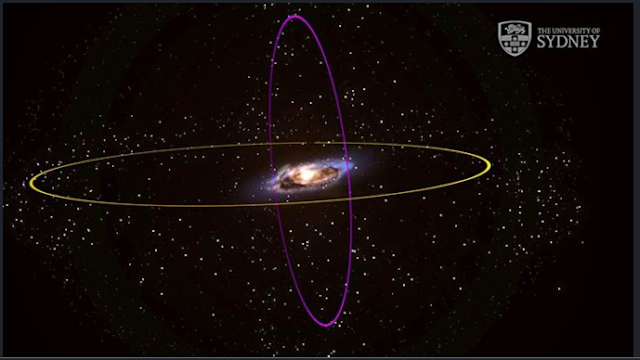Our Galactic Neighbour is a Cannibal
Did you know our neighbour is a giant cannibal?
Well, a giant cannibal galaxy. That's right, the Andromeda galaxy is a cannibal. Space is amazing, there are zombie galaxies, tadpole shaped galaxies, two galaxies that give the effect of menacing eyes, and, of course, cannibal galaxies.
Andromeda has been consuming smaller galaxies for at least 10 billion years! It is estimated that in another 4.5 billion years, our galaxy, the Milky Way, will collide with Andromeda. Scientists aren't sure who will win the battle or if it will end in a draw, but don't worry, humans will not be around. If climate change doesn't destroy us first, our sun will. Our sun is heating up and will likely make Earth unlivable in about 1 to 5 billion years.
The scientific study, published in Nature on October 2, 2019, believes that Andromeda has consumed at least two other galaxies. The first they could identify would have taken place when it was still a young, developing galaxy and the more recent one would have taken place within the last few billion years. As some of these events occurred billions and billions of years ago, the original larger "meal" could have been several smaller galaxies. They are hoping scientific advancement and newer telescopes under construction, such as the European Extremely Large Telescope (and yes, that is the name), will provide more information.
The scientists (from all over the world), "probed the digested remnants of these galactic binges with the Pan-Andromeda Archaeological Survey (PAndAS)" which is operated by the telescope on the summit of Mauna Kea in Hawaii. PAndAS is part of the galactic archaeology field. In this case, PAndAS focuses on studying the origin, structure, and evolution of Andromeda.
So why are they using the term "binges"? Simply put, other cannibal galaxies scientists know of seem to slowly take in galaxies. Andromeda, however, seems to of had two points in its history where it either consumed larger galaxies or numerous smaller ones.
So how did they tell the Andromeda had two binges? They found two groups of globular clusters (dense populations of stars) orbiting the galaxy at perpendicular angles from each other. Sound confusing, don't worry, it's actually pretty simple. One cluster orbits the galaxy at one angle, and the other orbits at a different angle. They are not parallel to each other, like we typically see in depictions of the planets in the Milky Way when they orbit the sun or the rings of Saturn. This is likely a result of their original locations when Andromeda consumed them.
Dougal Mackey (research fellow and astronomer at the Australian National University), who co-led the study, told Vice in an email, "the globular clusters that were measured were probably not formed when smaller galaxies were shredded by Andromeda. The most likely scenario, based on the properties of the clusters, is that they were formed in the smaller galaxies, and when those galaxies were later destroyed by Andromeda, the clusters were deposited into Andromeda's halo."
But, colliding with the Milky Way will be an interesting event. Why? Well, we are also a cannibal galaxy, just not as "hungry" as Andromeda. That we know of, anyway. The Milky Way has an ancient shell structure of stars, which indicates that the Milky Way has cannibalized some smaller systems over its history. Scientist have identified 13 stars in this halo.
Plus, the two galaxies are believed to have roughly the same mass. This means the Milky Way, also a cannibal galaxy, will not be an easy meal for Andromeda. Mackey believes the collision will destroy each galaxy's spiracle-shaped disks and lead to one elliptically-shaped disk. The good news, is that the collision is unlikely to damage or disrupt individual star systems within the two galaxies, so if there is still life on Earth by then, they should be okay.
If you liked this post, please share it!
Ferreira, Becky, "A Nearby Cannibal Galaxy is Going to Eat the Milky Way, Scientists Say." Vice. October 2, 2019. https://www.vice.com/en_ca/article/3kx54v/a-nearby-cannibal-galaxy-is-going-to-eat-the-milky-way-scientists-say-andromeda
Pappas, Stephanie. "The 15 Weirdest Galaxies in our Universe." Live Science. October 17, 2019. https://www.livescience.com/weirdest-galaxies.html
Wall, Mike. "Hubble Telescope Reveals Milky Way Galaxy's cannibal Past." Space.com. February 26, 2013. https://www.space.com/19964-milky-way-galaxy-cannibalism-hubble.html
Well, a giant cannibal galaxy. That's right, the Andromeda galaxy is a cannibal. Space is amazing, there are zombie galaxies, tadpole shaped galaxies, two galaxies that give the effect of menacing eyes, and, of course, cannibal galaxies.
Andromeda has been consuming smaller galaxies for at least 10 billion years! It is estimated that in another 4.5 billion years, our galaxy, the Milky Way, will collide with Andromeda. Scientists aren't sure who will win the battle or if it will end in a draw, but don't worry, humans will not be around. If climate change doesn't destroy us first, our sun will. Our sun is heating up and will likely make Earth unlivable in about 1 to 5 billion years.
The scientific study, published in Nature on October 2, 2019, believes that Andromeda has consumed at least two other galaxies. The first they could identify would have taken place when it was still a young, developing galaxy and the more recent one would have taken place within the last few billion years. As some of these events occurred billions and billions of years ago, the original larger "meal" could have been several smaller galaxies. They are hoping scientific advancement and newer telescopes under construction, such as the European Extremely Large Telescope (and yes, that is the name), will provide more information.
The scientists (from all over the world), "probed the digested remnants of these galactic binges with the Pan-Andromeda Archaeological Survey (PAndAS)" which is operated by the telescope on the summit of Mauna Kea in Hawaii. PAndAS is part of the galactic archaeology field. In this case, PAndAS focuses on studying the origin, structure, and evolution of Andromeda.
So why are they using the term "binges"? Simply put, other cannibal galaxies scientists know of seem to slowly take in galaxies. Andromeda, however, seems to of had two points in its history where it either consumed larger galaxies or numerous smaller ones.
So how did they tell the Andromeda had two binges? They found two groups of globular clusters (dense populations of stars) orbiting the galaxy at perpendicular angles from each other. Sound confusing, don't worry, it's actually pretty simple. One cluster orbits the galaxy at one angle, and the other orbits at a different angle. They are not parallel to each other, like we typically see in depictions of the planets in the Milky Way when they orbit the sun or the rings of Saturn. This is likely a result of their original locations when Andromeda consumed them.
 |
| The purple ring is binge one and the yellow ring is binge two. This is a still shot taken from a video on The Sydney Morning Herald website. (Image Credit) |
Dougal Mackey (research fellow and astronomer at the Australian National University), who co-led the study, told Vice in an email, "the globular clusters that were measured were probably not formed when smaller galaxies were shredded by Andromeda. The most likely scenario, based on the properties of the clusters, is that they were formed in the smaller galaxies, and when those galaxies were later destroyed by Andromeda, the clusters were deposited into Andromeda's halo."
But, colliding with the Milky Way will be an interesting event. Why? Well, we are also a cannibal galaxy, just not as "hungry" as Andromeda. That we know of, anyway. The Milky Way has an ancient shell structure of stars, which indicates that the Milky Way has cannibalized some smaller systems over its history. Scientist have identified 13 stars in this halo.
 |
| The Halo is the area around the disk. You can see to the Shell to the right. The Shell is where the 13 stars are located. (Image Credit) |
Plus, the two galaxies are believed to have roughly the same mass. This means the Milky Way, also a cannibal galaxy, will not be an easy meal for Andromeda. Mackey believes the collision will destroy each galaxy's spiracle-shaped disks and lead to one elliptically-shaped disk. The good news, is that the collision is unlikely to damage or disrupt individual star systems within the two galaxies, so if there is still life on Earth by then, they should be okay.
If you liked this post, please share it!
Pappas, Stephanie. "The 15 Weirdest Galaxies in our Universe." Live Science. October 17, 2019. https://www.livescience.com/weirdest-galaxies.html
Wall, Mike. "Hubble Telescope Reveals Milky Way Galaxy's cannibal Past." Space.com. February 26, 2013. https://www.space.com/19964-milky-way-galaxy-cannibalism-hubble.html


Comments
Post a Comment